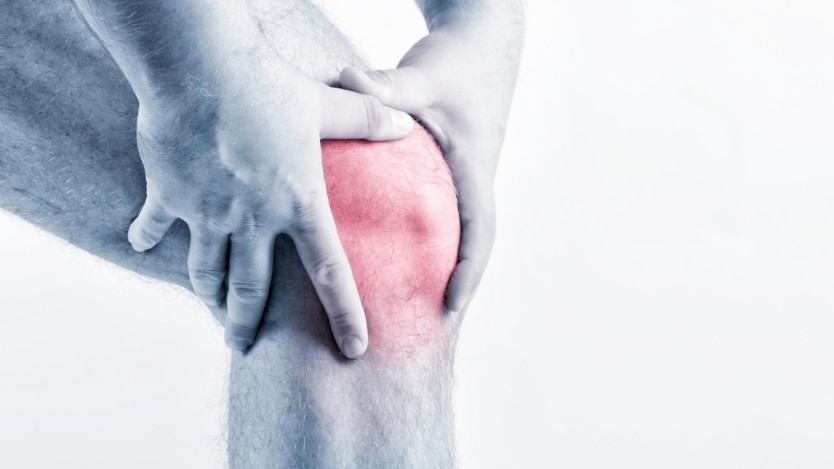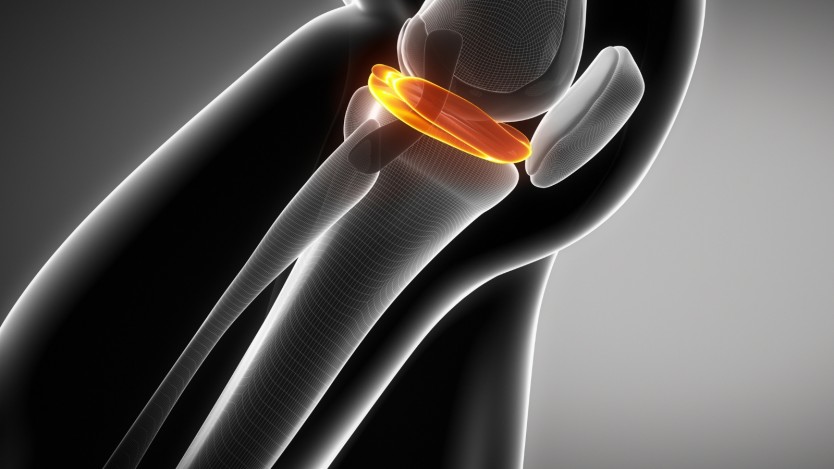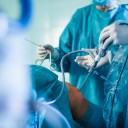Meniscus repair by arthroscopy, what do you need to know?

- The knee joint
- What is the meniscus?
- What is the function of the meniscus within the knee?
- How does a meniscus tear occur?
- What are the symptoms of a meniscus tear?
- Arthroscopic meniscus repair surgery: step by step
- How long is the recovery time after arthroscopic meniscus surgery?
- What are the advantages of meniscus surgery by arthroscopy?
The knee joint
- The knees are the joint in the human body that suffers the most during a person's lifetime as they support the entire weight of the body.
- A torn meniscus is one of the most common sports injuries, and in most cases it needs to be repaired surgically.
- Meniscus repair by arthroscopy is a minimally invasive procedure that considerably reduces recovery time and hospital stay.
The human body has 360 joints, of which the knee is the one that suffers the most as it has to support almost the entire weight of the human body on a daily basis. This is one of the main reasons why it is also one of the most injured and worn out joints, especially during sports such as football, basketball, rugby and so on.
Among the possible pathologies or injuries that the knee can suffer throughout a person's life, meniscus tears are one of the most common. This tear usually occurs during sports practice, and together with cruciate ligament injuries, it is the most common knee injury.

Do you need meniscus surgery?
Request a free and immediate appointment with our specialists in Traumatology
What is the meniscus?
First, each knee has two menisci located between the femur and tibia. One is located on the inside of the knee, called the medial meniscus, while the other, the lateral meniscus, is on the outside of the joint. Both are attached to the top of the tibia (the shin bone) but are also in contact with the femur bone.
The two menisci of the knee are crescent-shaped although they are not exactly the same. Both the medial and lateral menisci are thicker on the peripheral side than on the inner edge, where they are thinner. The medial or inner meniscus is more vulnerable to injury than the lateral meniscus.

The constitution of the meniscus is mostly avascular cartilage on the inside, while the outside of the meniscus is vascular and fibrous. By way of clarification, the vascular tissue is the one that receives the blood supply, which is why during meniscus repair an attempt is made to preserve this area by suturing the tissue rather than removing it.
What is the function of the meniscus within the knee?
The meniscus considerably increases the articular surface, which allows for a more even distribution of the weight load between the femur and tibia, as these bones alone would not be able to form a joint because they "do not fit" together.
In addition, the meniscus provides stability to the knee, improves the functionality of the knee and, thanks to its cushioning, provides better shock absorption and a consequent reduction in the wear and tear of the cartilage that covers the bones that form the knee (wear and tear whose consequence is, for example, osteoarthritis).
During knee movement, the menisci move. In flexion, the menisci move backwards, while in extension they move forwards.
Another function of the menisci is to help lubricate the joint by releasing synovial fluid during extension and flexion movements as well as during weight bearing and unloading.
At the time of a meniscus tear, the knee may be partially or completely locked, depending on the severity, causing severe pain on both sides of the joint.
How does a meniscus tear occur?
Meniscal tears are common in both young and older people. This tear can occur in several ways, either due to a tear in the inner part of the meniscus, which is called a bucket-handle tear, the free edge coming loose, or due to degeneration of the meniscus tearing in multiple directions.
The big difference lies in the causes of a meniscus tear, which vary according to the age of the individual:
- The menisci of people under the age of 30 are usually very elastic and resilient. Because of this, meniscal tears that occur at this age are usually due to severe trauma with twisting of the knee. They tend to occur mainly during sports such as football, basketball, rugby, etc.
- Over time, the meniscus weakens and loses strength, increasing the likelihood of meniscal tears due to less severe twisting trauma than in younger people.
- Finally, degenerative tears caused by wear and tear of the meniscus can occur and are part of osteoarthritis of the knee.
What are the symptoms of a meniscus tear?
When a meniscus tear occurs, the patient feels a popping sound in the knee followed by a sharp pain throughout the joint. When the meniscus tears, the patient loses the ability to fully straighten the knee and feels pain when walking.
If the meniscus tear is not repaired, the continuous rubbing of the damaged meniscus against the cartilage of the joint bones is likely to cause wear and tear and fragmentation of the meniscus, leading to acute degeneration of the entire knee. For this reason, meniscus surgery is recommended by the vast majority of surgeons for almost all cases.
Arthroscopic meniscus repair surgery: step by step
Meniscus repair by arthroscopy is a minimally invasive surgery that makes it possible to repair the meniscus without having to open the knee, which considerably reduces hospitalisation and recovery times. In order to perform this surgery, a series of preoperative consultations are required to determine the extent of the injury and the anaesthesia to be used.
Preoperative for meniscus surgery by arthroscopy
Once a doctor has diagnosed that it is a meniscus tear, because as it is in the knee it may also be a ligament tear, the extent of the injury is determined by means of a meniscus tear, because as it is in the knee it may also be a ligament tear. To determine the extent of the meniscus tear, various tests can be carried out, the most commonly used being ultrasound or X-ray.
After performing these tests, the results are taken to the specialist who decides whether it is necessary to operate or whether it is possible to regenerate the meniscus with some other non-invasive treatment (if the pain is severe, it is usually necessary to operate).
If it is finally decided to carry out the operation to repair the meniscus, the surgeon will explain the whole process to the patient and answer any questions the patient may have. A date will be set for the operation and also for the pre-operative period.
During the pre-operative period, the patient will undergo all the necessary tests to determine his or her state of health: electrocardiogram, blood tests, etc.
In addition, you will have a private consultation with the anaesthesiologist, who will review the patient's medical history and ask a series of questions about lifestyle habits in order to determine the exact anaesthesia to be administered during the operation.
This point is important to emphasise as one of the fears of patients is that they will be given the wrong anaesthesia or that they will be given too much or too little anaesthesia, when the reality is that anaesthesia is specific to each patient according to their own characteristics.
The day of the meniscus repair surgery
This intervention requires admission to hospital, so the patient must go to the hospital several hours before the start of the surgery or the night before if the surgery is to be performed in the morning. On arrival at the centre, the patient must present all the documents required for admission. You will then be taken to your room until the surgery begins.
- At the time of the operation, the patient is escorted to a room where he/she will be asked to undress, remove all metal items and put on an operating gown and slippers. You will then enter the operating theatre and be positioned on the operating table as instructed by the surgeon.
- During the operation, the medical team in the operating theatre will consist of the surgeon, a member of the nursing team, the anaesthetist, whose role is to monitor the patient's vital signs throughout the surgery, and in some cases a resident doctor to observe.
- General anaesthesia is administered for meniscus repair surgery, so the patient will remain asleep without feeling or remembering anything during the operation.
- Once the anaesthesia takes effect, the surgeon will disinfect the affected knee area, shaving it if necessary. He then makes 3 to 4 small incisions in the joint area.
- Through one of these incisions, a cannula is introduced that injects a saline solution into the joint cavity so that it remains widened during surgery. This allows the surgeon to have greater manoeuvrability and better visibility, avoiding possible damage to the other elements of the joint.
- The surgeon inserts the arthroscope through one of the incisions and looks inside the knee. The arthroscope consists of a tiny camera connected to a monitor via fibre optics. The surgeon will see inside the knee on the monitor, allowing him or her to repair the meniscus without opening the knee.
- Meniscus repair involves suturing or removing the damaged part of the meniscus. The difference between one solution and the other is determined by the severity of the tear or the part of the damaged tissue. In the case of a tear in the vascular area of the knee, we will try to preserve as much of the tissue as possible by suturing it.
- To perform the repair, the surgeon inserts the surgical instruments through the remaining incisions and works on the basis of what he sees on the screen. Today, some hospitals are using 3D technology to perform this type of surgery, which allows the surgeon to better perceive depth and in turn, improves patient safety.
- Once the meniscus has been repaired or removed, the surgeon removes the arthroscope, surgical instruments and drains the serous fluid from inside the knee. He then sutures the incisions made and dresses the area.
- The patient is taken to the resuscitation room where he or she remains until the vital signs are stabilised.
How long is the recovery time after arthroscopic meniscus surgery?
After the meniscus repair operation and the stay in the recovery room, the patient is taken to his or her hospital room. The hospital stay is usually no longer than one night, and it is sometimes possible for the patient to go home the same day as the operation.
At home, surgical wound care is much easier than in conventional open surgery, and the wound heals more quickly. Recovery can last from several weeks to 3 or 4 months, with the use of a cane or crutch being necessary during the first few weeks to avoid placing all the weight of the body on the operated leg.

The duration of rehabilitation after meniscus surgery by arthroscopy is shorter than in conventional surgery, but the effort and intensity with which the rehabilitation exercises are carried out has a lot to do with it.
Once rehabilitation is complete, the patient can return to sport without any problems, and can start walking unaided a few weeks after surgery.
What are the advantages of meniscus surgery by arthroscopy?
The main advantage of meniscus surgery by arthroscopy is the solution or repair of the damaged meniscus, allowing the patient to return to a normal life without pain and to return to sport. In addition, the use of a minimally invasive technique such as arthroscopy has the added advantage that the postoperative recovery time is much shorter than in conventional surgery, while also reducing the length of the hospital stay.
For more information on meniscus surgery by arthroscopy, click on the following link:

Do you need meniscus surgery by arthroscopy?
Request a free and immediate appointment with our specialists
Medical disclaimer: All the published content in Operarme is intended to disseminate reliable medical information to the general public, and is reviewed by healthcare professionals. In any case should this information be used to perform a diagnosis, indicate a treatment, or replace the medical assessment of a professional in a face to face consultation. Find more information in the links below:
